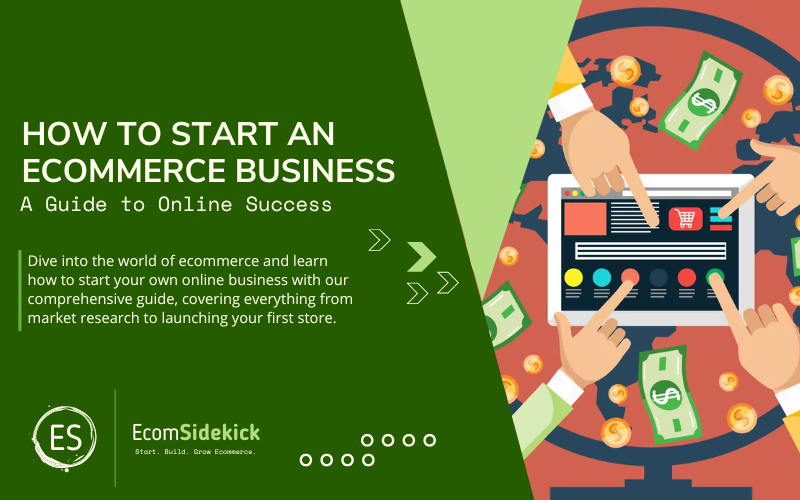Introduction
Ecommerce is a new fact of life, a new type of business that has taken off a storm since the internet performed an inception upon our world. Of course, no one is complaining, it has helped people start up their own independent businesses and leave the droll 9-5 behind them.

Of course, just like starting any business, starting an ecommerce business won’t be easy, however the ability to set up a business, launch and maintain it is more accessible than it has ever been before. That said, understanding the history and future of ecommerce will be super helpful before you begin your journey.
So, how to start an ecommerce business and how to get off the ground? Well, let’s talk you through it, today!
What Is An Ecommerce Business
Instead of just jumping straight into how you can start off your ecommerce businesses, we want to ensure that you have a good understanding of what ecommerce actually is.
Many people will have an idea, but few are totally sure, and if you want to get your mitts into this area of the business world, then you will want to ensure that your understanding of ecommerce is 100%!
It’s not as simple as just understanding the premise, but everything about it as a whole, what it is, how it works, the influence it has on the modern market, and how it grows.
You might be surprised to learn that there are many big businesses these days that are actually ecommerce, that you may never have even realized were. So, that is where we will begin, we want to open your eyes to what ecommerce is, and the keys to understanding it.
What Is Ecommerce
Ecommerce stands for electronic commerce, which basically means that it is internet run. It is a reference to business models that allows individuals and companies to sell or buy services and goods over the internet.
Pretty standard in this day and age right?
It operates via four major markets, and it can be done through smartphones, tablets, computers and pretty much any smart device you have at your disposal.
Pretty much every product that you can think of is available via ecommerce, from music, to books, clothes, plane tickets, even stocks and investments!
This is why it is considered to be something of a disruptive technology.
In fact, all the times that people blame the internet for the reduction in people who go to physical shops and buildings to get products and services, it is actually ecommerce that people tend to blame.
But, how can you blame it? It’s easier than the alternative!
Understanding Ecommerce
To be simple about this, e-commerce is just the simple process of selling and buying genuine and tangible services and products online. It involves multiple parties as well as the smooth exchanging of currency or data in order to process any single transaction that takes place.
It is overall a part of the industry that is known as ebusiness, and you can guess that this means electronic business.
Electronic business involves all of the above explained processes which are required to adequately run a company online.
It is all about making sales and buying products off the internet. This is the most basic form of understanding about what ecommerce is. Also take a look at some powerful ecommerce statistics to get a deeper understanding.
It helps small businesses and those with a more slim reach to be able to access a wider market presence by giving cheap and efficient channels of distribution with their products. A great example of this would be ‘Target’, who used an online store to allow customers to purchase items from the comfort of their homes!
Now Target is HUGE, but there is massive benefits to being small and mobile. Just take a look at these small business revenue stats to get inspired!
How To Start An Ecommerce Business

Back around a decade ago, doing an online shop was seen as a luxury or convenience, but now it’s a necessity. Where would we be without our online shopping carts?
Ecommerce has been growing quite substantially for quite some time now, and there are often examples of ecommerce sellers who get so much business, keeping up stocks is quite the challenge!
So, how do you go about starting an ecommerce business that can bring you this much success? Let’s see…
Research The Ecommerce Space
Before you do anything at all you need to start researching. You should never, ever start any business venture based off of just a hunch! Growing an online business is an investment, and you should treat it like one.
There will be no structure for business that will work for every single person, and with services, bases, software, digital sales, and physical products are just the tip of the pyramid, there is a whole load going on below.
So, before you decide on what you are selling, you have to get a good understanding on what the different business models are, and what is available to you. It’s not hard, but your decisions early on will impact the structure of your business overall.
Find Your Niche
This means you need to find your niche. Your niche should be something that you are passionate about and will enjoy working on, even if it is a competitive market, (most are these days anyway), if you enjoy it, you will be more inspired to put time and effort into it.
However, you should also be thinking about the process too, how the niche looks overall in the market, ignore competition right now and focus on the customers, think about start-up costs and if there are any legal regulations around the niche.
Question everything, and consider how it will look, use your imagination, and you can build a great business model from here.
Create Your Business Name
Once you have your niche settled and have done adequate research into your area, you will need to choose a name for your business.
You want to choose something unique, that won’t infringe on any other businesses, but you also want to give the business a name that is a good indicator of what you do.
It is wise to consult the local secretary of state website, and the U.S. Patent and Trademark Office to make sure that you do not accidentally take on a name that is already taken.
Of course, you don’t want to be thinking about a website too much right now, you might want to see if the domain name is available too.
Validate Your Target Market

You might want to start looking for products to sell at this point, but don’t, before you even start thinking about that, you need to consider personas. You can have absolutely no expectations that people will buy from you if you do not know your audience.
So consider yourself, who are you and what will your business represent, who are you ideally going to be selling to. This means you need to be able to project a brand image that is consistent and clear, starting with the name of course.
Thankfully, social media makes audience targeting pretty easy, get an idea of your target audience through social media!
Complete All Legal Documents
Now, here comes the dull part. Okay, up until now the process has been pretty creative, research, imagining the ways you can go about this, coming up with ideas and brainstorming with yourself about how you will get this business to work and who you are targeting.
Now we need to think about the legal side of things, with any form of business, you need to set up and complete all your legal documents, and there are a few. Ideally this should not be too long of a process, but it is a very important part of starting a business.
Whether you are setting up an ecommerce business or a brick-and-mortar business, legal documents are always going to be part of it.
Apply For An EIN
Now you need to apply for an EIN, which is an employer identification number. You need this for your business, although not every business does need one. It is a 9 digit number which will be useful in separating business finances from personal finances.
This is super helpful when it comes to doing the money managing paperwork that comes with a business.
You can apply for this number from the IRS for free as well, done by phone, mail, fax, or online. Since you are also learning how you’re starting an online business, you will do this online, and you will get your EIN straight away!
Apply For Your Business Permits
Next up is getting your business permits. You will need this to be able to legally operate within your state and your city.
If you establish your ecommerce business as being a single proprietorship, or even a general partnership, you won’t actually need to register it with the state, however this is excused if you need to file a DBA to operate under a particular name.
If otherwise you will need to register with the state and need to receive a general operating license.
You might also need to get your hands on an operating license as well, but this is more dependent on where your business is actually located, make sure you know what applies to you.
Apply For Your Business License
A majority of ecommerce businesses will be home based, so they do not need quite as many business licenses or permits as the businesses that are run brick-and-mortar (another reason for their rising popularity).
Yet, you do want to determine what are the specific requirements of your area. This information is not hard to gain access to, as most of it should be readily available to you through your state website, or the local government website.
A majority of locations will specify that home-based ecommerce operations need to receive a home occupation permit in order to operate legally. It just shows that by doing so, you aren’t adding any traffic, or otherwise ‘neighborly’ conditions to the local area.
Choose Your Platforms
Once you have done all the paperwork that is needed to register and start your e-commerce business legally, you are now well on your way to having a successful ecommerce business.
The majority of the steps you have taken thus far have been pretty similar to what you would have to do to start up a normal brick-and-mortar style business. However, now you do not need to choose a location to set up a physical store, now it comes to the online part.
Start from finding your platform, thinking about your domain name. Whether you use an all-in-one system like Shopify, or an open source platform, it is up to you but now is the time to decide.
Create Your Site

A majority of e-commerce platforms will allow you to create your own store and launch it, but they should also allow you to customize the design and add in your domain as well as take and ship orders, manage your inventory and receive payments.
While there are many of these platforms available, there are some popular ones, such as Shopify, Woocommerce, Magento, Squarespace, and so on.
There are a lot of important considerations you need to be taking at this point, You need to think about the features, and usability of this platform, and how it will affect your day-to-day running
Get The Right Payment Processor
Of course, you are going to want to get the right payment processor as well. Of course a majority of people will lean towards PayPal as it is one of the most used payment processors in existence.
PayPal is probably the best choice, and if you are already familiar with how it works, then you will probably find it is the best choice for you.
Alternatively there is also Stripe, Square, Payline Data, Due, Ayden, BitPay and so on. There are plenty of choices, but you want to make sure that whatever you choose is compatible with both you and your online store as well.
Related payment processing resources to help make an informed decision:
Ideally it should be straightforward and easy to use, which is often why PayPal is very popular for this.
Equally as important as a payment processor, is a good POS system for your business. Depending on the type of ecommerce business you are setting up, this could be a critical success factor.
For instance, if you are setting up an Amazon store, it is not necessary, but if you are setting up a robust skin care brand, it is super necessary.
Source Your Product
Now that you have decided upon your ecommerce platform and your payment processor, and are generally on the way, you are pretty much nearing the end of the process, but now it is time for you to source your products that you will be selling to customers.
Ideally, you should’ve thought about how you will do this already, you should have performed some research at the beginning of your journey to starting an ecommerce business.
You might make your own products, or perhaps you source them from external sources. You might sell your own skills, perhaps being a consultant, an artist, and you might only need to list your services on your site.
Source Your Fulfillment Provider
A fulfillment provider includes warehousing, pickers, packers, shipping, and if necessary, returns. A fulfillment service will do all of this for your e-commerce business. In its simplest forms, it is simply about preparation and delivery of the customer orders.
If you are a small business or new (which you are), you could probably handle this yourself, but there will be many things going on, and without a bit of help you risk the mishandling of every important part of this business.
This would make the profitability suffer, so it is wise to seek out a fulfillment provider. These are just third-party warehouses which will assemble and ship customer orders.
Source Your Customer Service Provider
Choosing a customer service provider is just as important as sourcing a fulfillment center. As you yourself may already know, a business can be amazing, but if their customer service leaves much room for improvement, then it can lower their rating.
This is why it is so important to be careful about who you pick to be your customer service provider, you should look at reviews of companies that provide this service. If the customer service is good, your customers are more likely to recommend you to others.
Of course, you could use bots, but these are unreliable and frustrating for people, as you probably know yourself, so it is better to outsource your customer service needs.
Create A Marketing Strategy
Now, the hard part is over, it is time for the next hard part. Marketing is a whole individual world on its own, and it is not always as easy to manage as some may think. You need to consider your audience, and where they will be most likely to see you.
This means you can use Google Ads, social media ads, traditional marketing like billboards, TV, and newspapers.
Of course, the most popular form of marketing these days is through social media and advertisements online.
However, at the base level you want to optimize your site for SEO and take advantage of any tools that are included within the platform you use.
Tips To Starting An Ecommerce Business

Now that you know the steps on how to create an ecommerce business you are well on your way to success, go you! However, it is not quite as simple as it may seem, there are other things that will increase your overall success rate.
This is why we are going to add some top tips to help you optimize your ecommerce business for success as well, helping you build the best business you can.
It can start from the first step in research all the way to marketing.
Simplicity Is Key
Never forget that less is more. Sometimes, some of the best ideas actually come from being really simple and uncomplicated. People do not want to see a lot of chaos on a website, they don’t want to spend ages on a site trying to figure out how to find what they want.
The simplest things pay off and the saying that less is more really applies here. The more complicated you make something, the chances are it will not work as well. Sometimes simply starting something out as being a store on a WordPress can grow into something more.
Starting off simple and small can help you refine your whole process and iron out faults easier, starting small isn’t wrong, sometimes it’s the right way to go.
Share Across Multiple Ecommerce Channels
Ecommerce channels can benefit a huge amount from having social media, you see, social media is great for gathering a following, and sometimes before you even get your business rolling, getting your social media up and running can be useful as you gain a following ready.
Facebook, Twitter, Snapchat, Instagram and so on can be super useful as you start up, it is free, and you can use it to drop hints, and market your adverts early and easily.
You can build up excitement for your target audience with these, and it can be a gateway to better and bigger things, it’s like an open door that you do not have to pay for.
It is best to make the most of what social media can offer you.
Only Share Your Financials With A Processor You Trust
When it comes to picking out a processor to process the transactions you need to make sure that you trust them. Like anything, you must remember that businesses require a functional financial system, and the processor will be at the core of that.
This is another reason why people tend to lean towards Stripe or PayPal more than many other providers, they are often seen as trustworthy, and since they are so regularly used in many markets, they have a trustworthy reputation.
Whether you choose Stripe, PayPal or another processor, you need to be able to trust the provider that you use with the money flowing between the customer and you.
Browse these resources to help you make a more informed decision on processing:
Know Your Target Audience
This is why you need to do extensive research into the area that you are going to be selling/ providing a service. You need to know and understand your customer.
You need to know what they want, where they will be active to see your marketing, get an idea of what appeals to them, your brand name, slogan, website, and selling process should ideally be tailored to their satisfaction and keep them interested in you and the product/ services that you offer.
Do research, perhaps even put out some surveys or polls to get to know your target audience on a better level, so you can deliver just what they want.
Focus On Repeat Customers
While it may feel good to get in multiple customers, what you really want to be focusing on is repeat customers. If you get repeat customers, it means that what you are selling is good, and the way in which you sell is good. It is like feedback.
Also having repeat customers means that you can gain feedback from them, and your sales will increase, you can also better make projections of sales and get a more stable idea of where your business is at when you do your financing.
One off purchases are good, they do still bring in money, but repeat customers give you a better idea of how happy customers are with your business.
Keep Up To Date With Trends
Sometimes we do not quite understand trends, like how businesses have integrated into the world of TikTok. It does not always make sense to all of us, but it is wise to keep up to date on trends.
No matter what business you are in, the market will be competitive on one level or another, and keeping up with trends prevents your competition from catching ahead on you.
If there is new technology, a new app, or some new way that people are using marketing strategies or sales, stay up to date and utilize what new trends you can. This is how businesses can build, and an adaptable business is one that will be around longer.
Maintain Great Customer Service

Customer service can be defining factors for a company, if you go on review sites you will usually see that while people do put a lot of stock into the quality and speed of the product/ service delivery and the smoothness of the running of the business, it is not the only thing.
People will focus a lot on customer service as well. We all want to feel assured that if something goes wrong along the line somewhere that we will easily be able to resolve the issue. This is why bots are not highly recommended for many.
If you use a customer service provider, ensure you are happy with the quality of the service they provide, if you are happy with them, your customers should be too!
Have A Great Website Design
Nothing brings people in quite as well as a website that is aesthetically pleasing. If your website looks drab and boring, people are hardly going to hang around for very long.
However, the website shouldn’t look cluttered or like you’re trying too hard. Less is more applied here. You don’t need stickers, GIFs and huge chunks of text all over your website. Get the message across in plain and simple imagery and text.
Make it eye-catching but relevant, and easy to read. No one is going to read 1,000 words upon entry to your website. Introduce color and pictures to keep it lively, even if your site color scheme is black and white, it can still be visually appealing.
Focus On Conversion Optimization
Now, to scare you with some numbers. Only around 69% of the visitors to your website will actually purchase something, so that means that only 31% are going to make purchases.
Consider how much your revenues would go up if you managed to catch a few more of those people instead of having them leave. This means you need to optimize the customer’s journey, include offers, launch an email campaign for abandoned carts, and try retargeting.
Try out different techniques to turn those site views into sales, instead of just having that 31% of sales.
Work On Your Store Frequently
Part of this means that you need to always be upgrading your store. Nearly half of online shoppers will tell someone if they had a bad shopping experience online And while the other half don’t, it’s not good news for you.
Once you have your ecommerce business nailed, the next thing you need to do is optimize your website to ensure that it is perfect for your customers.
Make the navigation bar intuitive, increase website speed, and make the product display pages look great.
Optimize the website to be the best it can possibly be for your customers, and always check how it looks on mobile devices! We often forget about mobiles, but a majority of people shop via their phone now, so make it look good!
Update Your Inventory When Needed
Products that are best-selling can fade quite fast, and inventory is very important. Sure, maintain old faithfulness that always gets sales, but you should also be looking for new innovative ideas to add to your product roster.
New things will bring people into your store, curiosity will always bring people in, and so bringing in new things will help.
Relying on a few products to keep your sales coming won’t always work, note that in this day and age we have a short attention span, and so, it is important that you maintain people’s attention with your products, keep them interested with new things!
Try looking into new ideas based on the trends on Google!
Importance of Outsourcing Talent

Let’s discuss something that’s crucial to online businesses: the importance of outsourcing talent in the e-commerce realm.
The ones that get it will be nimble and pivot well. The ones that do not will be slow and get outmaneuvered by much smaller, faster competitors.
So, why outsource? It’s all about adaptability, flexibility, and staying in tune with the ever-changing landscape of e-commerce.
Outsourcing talent in the e-commerce industry holds great significance for several reasons.
Let’s dive deeper into the outsourcing details:
- Outsourcing Statistics: The increasing importance of the outsourcing trend is underscored by outsourcing statistics, which highlight its significant role in boosting efficiency, reducing costs, and allowing businesses to focus on their core competencies.
- Payment Flexibility: Technology excels here. Not too long ago, this would have to be done by expensive bank wires. That said, it is not just PayPal in this game anymore (the fees are upwards of 6%). There are solid up-and-comers such as Payoneer that are revolutionizing the way payments are made to teams worldwide. In addition to cutting the cost in half of the PayPal front runner. Learn more about how money transfers work for small businesses here.
- Cost-effectiveness: One of the primary reasons to outsource is to save on costs. By outsourcing specific tasks or roles, businesses can cut down on expenses such as employee salaries, benefits, office space, and equipment. This allows them to allocate resources to other critical areas, promoting overall growth and efficiency.
- Access to specialized skills: The e-commerce landscape requires expertise in various domains, including marketing, web development, and customer support. Outsourcing provides access to skilled professionals across the globe, ensuring top-notch services without the need to invest in extensive in-house training. This has exploded another bit niche for remote work called the gig economy. Take a look at these gig economy statistics to get an idea of how massive this trend is.
- Flexibility and scalability: E-commerce businesses often experience fluctuations in demand due to seasonal trends, promotions, or sudden growth. Outsourcing allows companies to quickly scale their workforce up or down, depending on their needs, without long-term commitments or overhead costs. It also allows for remote workers to thrive and live a more balanced life. Look at these work form home statistics to see the magnitude of this workforce movement.
- Faster turnaround times: Outsourced teams, often located in different time zones, can work around the clock, resulting in faster project completion and reduced time-to-market for new products or services.
- Enhanced focus on core competencies: By outsourcing non-core tasks, e-commerce businesses can concentrate on their primary objectives, such as product development, branding, and customer relationships. This strategic focus can lead to improved competitiveness and long-term success.
- Risk mitigation: Outsourcing can help e-commerce businesses minimize risks associated with talent shortages, employee turnover, or unexpected changes in the market. By partnering with specialized service providers, companies can ensure continuity and adapt more easily to challenges.
- Time Tracking: With the latest technological advances like TimeDoctor, you are able to track productivity more closely. These tools allow you to set the parameters of how tight or flexible you would like to run your team.
Outsourcing talent plays a pivotal role in the success of e-commerce businesses, offering cost savings, specialized expertise, flexibility, faster turnaround times, and more.
Final Thoughts
In many ways, starting a new ecommerce business is not all that different to starting a brick-and-mortar business, however, there is the online aspect that you need to spend some more time thinking about.
It can be a lengthy process, with a lot of thinking involved, but ensuring you do not miss any steps is the key to making sure that you start a successful business, even missing the tiniest thing can have repercussions later on. So, take things slowly and make sure you have everything covered, and don’t forget, less is more.
Frequently Asked Questions
What Is an E-commerce Business, and How Does It Work?
An e-commerce business involves buying and selling products or services online through a digital platform such as a website or mobile app.
What Are the Essential Steps to Start an E-commerce Business?
The key steps include defining your business idea and target audience, choosing the right products or services to sell, setting up your online store, sourcing inventory, and implementing a marketing strategy.
What Legal Requirements Should I Consider When Starting an E-commerce Business?
Legal requirements may include registering your business, obtaining necessary licenses and permits, complying with tax regulations, and ensuring your website’s terms and conditions are in place.
Paul Martinez is the founder of EcomSidekick.com. He is an expert in the areas of finance, real estate, eCommerce, traffic and conversion.
Join him on EcomSidekick.com to learn how to improve your financial life and excel in these areas. Before starting this media site, Paul built from scratch and managed two multi-million dollar companies. One in the real estate sector and one in the eCommerce sector.

